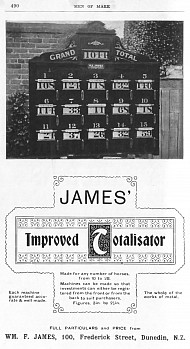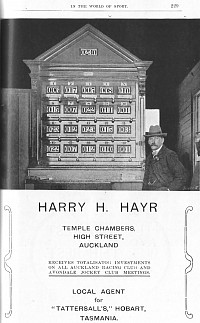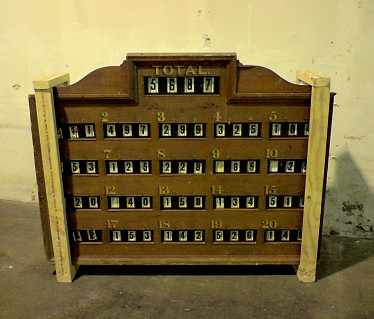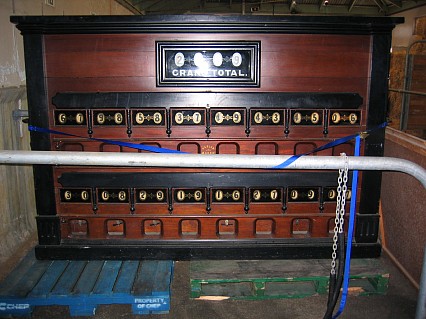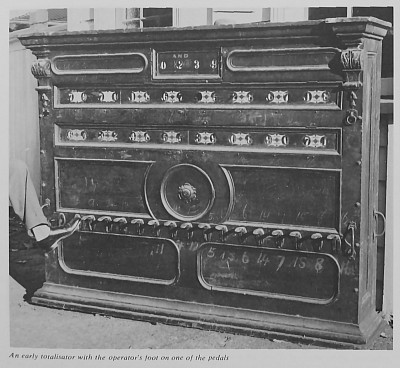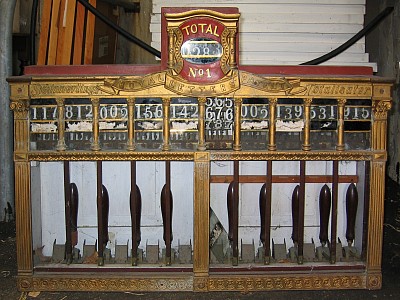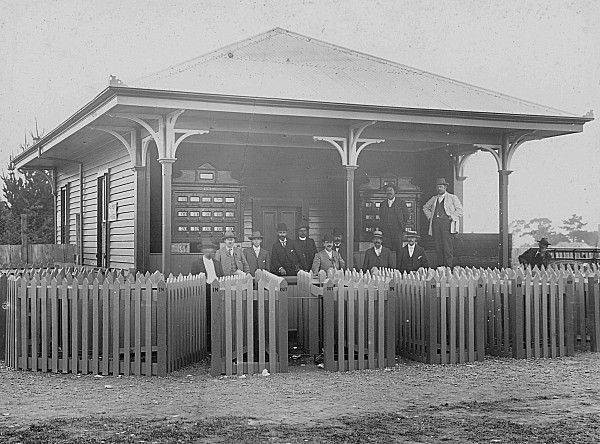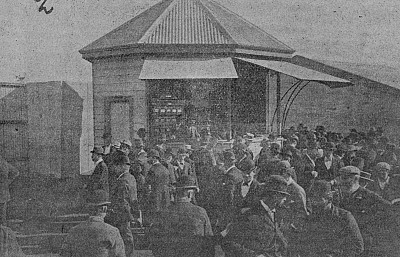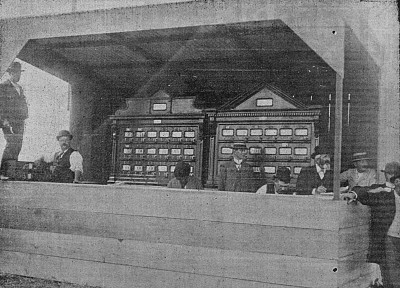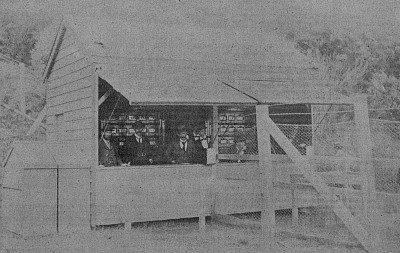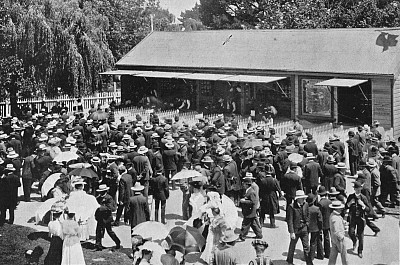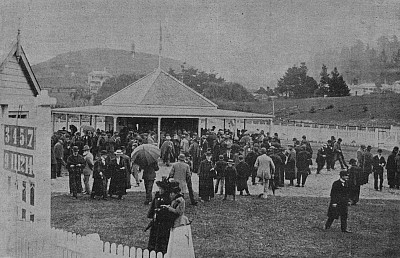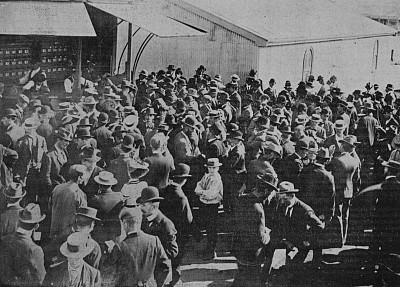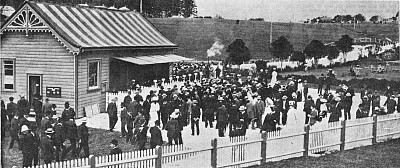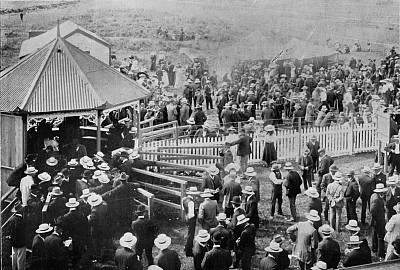Computer Science
Totalisators: Early Machines
Not much is known about the early totalisator machines. We have to work from a few photographs from the time - there were contemporary accounts of the totalisators in operation but these mainly concentrated on the daily takings. Alongside are two advertisements for locally-made machines taken from a book published in 1906.
Perhaps the first question to ask about these early machines is "why?" considering that the totalisator could be operated without any machinery at all. The initial answer seemed to be that the totalisator is easily subject to fraud. A bet with a bookmaker is a straightforward contract. The gambler and the bookmaker have both noted the contract and there is no dispute as to the outcome if the bookmaker is reputable – if there is a problem such as the bookmaker refusing to pay or being over-extended then it is gross and obvious. With the totalisator things are much less straightforward and there are many ways that the operator (in particular) can cheat. For example, inventing extra bets on unfavoured winners can reduce the payout, as can recording the bet on the horse but not on the grand total. Changing the totals while, or after, the race is run is another possibility.
Of course, this feeling of security is ill-founded as the machinery doesn’t stop the determined cheat - the tale is told of the operators of the very first machine at Ellerslie racecourse in Auckland in 1880 being caught cheating by inventing extra bets on outsiders. (Ref. The history of the Auckland Racing Club “A Noble Breed” by William Mackie.) True security can only come from the totalisator being supervised or operated by a trusted authority, which is why clubs were given control (though with government monitoring.)
There are only five machines known to have survived to this day, all in New Zealand. Two are held by the Otago Settlers Museum in Dunedin (one James machine similar to that advertised above). Two were in the New Zealand Racing Museum at Ellerslie and have been stored at Ellerslie since the museum was demolished. One machine is held by the Museum of Transport and Technology in Auckland (MOTAT) - for years this was thought lost but has been found again.
How these early machines worked has not been documented. A quick glance would indicate that they are very simple. Small mechanical counters were common knowledge - there do not appear to have been any local patents filed. It is not surprising, though, that some machines were put together locally to form a small local industry as in the advertisements above from 1906.
The early totalisator machines were considered to be in competition with bookmakers and were operated on the same scale by one man or a small team. The first machines were human sized - some were quite small and portable, others more like the size of a piano. The counts of bets were shown in large, easy-to-read, professional-looking fonts rather than handwriting. The typical machine would have levers to increment the count on each horse and to increment the grand total as well in the sight of the gamblers. Some machines would have locks set so that there could be no tampering while the race was being run. A typical machine would be like one of the two held in the Otago Settlers Museum on the left or another stored Ellerslie to the right:
The MOTAT machine was unusual in that it was operated by foot pedals:
Initially the machines were small and were taken from course to course. Some were very small indeed as for example one of the machines held in Ellerlsie stables, above. Initially there could be multiple machines with different owners operating at a race track with the permission of the club. But later the operation course-wide was contracted out to a single operator to manage and organise. Often the one operator would gain contracts for a number of courses in the local region. In Auckland, an important player was Mr Harry Hayr as seen in his 1906 advertisement above.
We do not know how inclement weather was handled initially but, once clubs had the monopoly, it was not long before special permanent buildings were constructed from which to operate the machines. These often had more than one machine to handle the demand. Typically, the early buildings would have a veranda to shelter the machines, their operators, and the punters at the head of the queue. We have one nice image from Wanganui - the gentleman at the right distinguished by his white jacket is Mr George Spriggens, the manager of the totalisator, who ran the totes in the area for many years.
Here are some other pictures of early tote buildings. There were a great variety. Some at the smaller courses were very rough. There was some flirtation with "round" buildings but the most common form was a rectangular building with sales and machines on the front side and payout windows at the back as in the Ellerslie example - note that the Ellerslie building sheltered 5 machines. These photos were taken from the Auckland magazine "Sporting Review" which covered both sport and the theatre and are from the Auckland Public Library, Sir George Gray collection.
We also do not know in detail how these early tote houses and machines were operated. However, it is said that the person taking the money and issuing tickets called out the bets to be registered on the machine. For many years the totalisators were in competition with bookmakers. The bookmakers made a lot of noise attracting and advertising odds and it is likely that the totalisator, with multiple machines and shouted bets, was also a lively scene - certainly there was no privacy for the bettor. When the course-wide manual totalisators started up they were, in contrast, termed the "silent tote".

